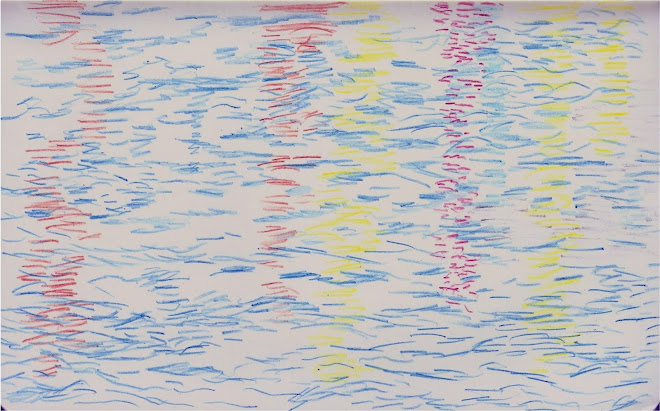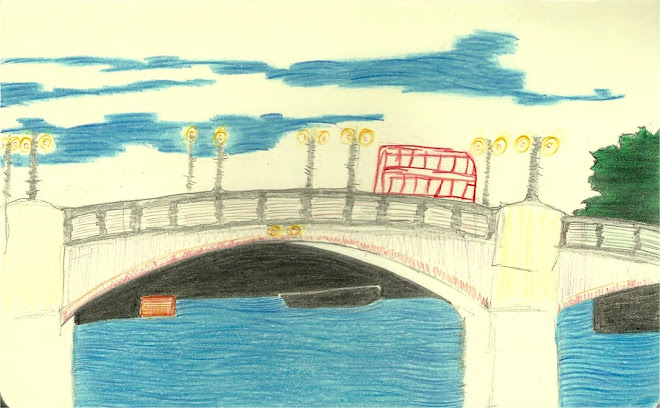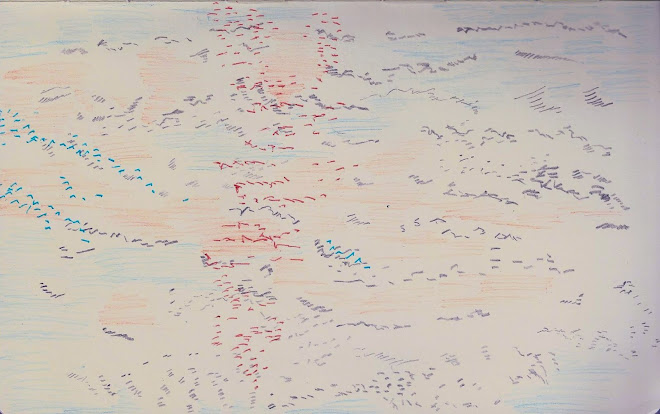More exquisitely detailed costume...
Traditionally, for an Oman man, a weapon was part of everyday dress. Fastened in a belt at the front of the tunic was a khanjar - a thick curved dagger sharpened on both edges. It was said to take a month or more to make the blade. The belt and the sheath were decorated with silver.
Traditionally, a dagger was also carried in Indonesia. Men wore their keris in a belt. Women might also wear a small sheathed keris, as a hair ornament. The blade might be straight, or the edges shaped in almost-parallel wavy lines, gradually converging. The craft to make these blades has been compared with the craft of samurai sword-makers.
The shape of waves can be elusive. At Blackfriars Bridge, with joggers behind me, I watched water as it lapped against the Embankment. I made a drawing.
Tuesday, 26 April 2011
Tuesday, 12 April 2011
British Museum: Parthenon Marbles
What can survive repeated conquest? On the Acropolis:
- The sanctuary for Athena was destroyed by Persians in 480 BC
- The Parthenon was completed in 432 BC, a Doric temple and treasure store
- In the 5th century AD the Parthenon was converted into a Christian church
- In the early 1460s it was converted into an Islamic mosque, with a minaret
- In 1687 a Venetian bomb exploded the Turkish ammunition store inside, causing destruction
- In 1806 an Englishman took some of the sculptures to England.
Perhaps Indonesia had more luck - the Portuguese, the Spanish, the English, the Dutch were interested in spices, not terrain. Before them, other sailors and merchants came to trade: Chinese, Arab, Buddhist, Hindu. And if later there were priests and dignitaries, their influence could be absorbed in a more gradual process. That is, until the final period of colonial rule, as enlightened nations were building their empires.
The Thames has been flowing for thousands of years. Today I watched it flow under Waterloo Bridge. Waterloo: one of the last stands of Napoleon the Conqueror. I made a drawing.
Monday, 11 April 2011
Tate Modern: Picasso
There was a room with several works from the 1930s, and a 1920s work in a separate exhibition. The subjects (objects?) were mostly women. It is astonishing to stand and stare as if this were an everyday occurrence, to be mere inches away, to see the overlaps of lines, to examine the edges and joins of coloured planes, and then walk backwards... and see the larger effect.
With a Sunday afternoon ice cream, I walked along the edge of the Thames to Southwark Cathedral, where bells were ringing, sounding like an Indonesian gamelan orchestra. One person starts, and everyone joins in, playing each percussive part in cycling patterns. In the breaks, bells could be heard across the water, at St Magnus the Martyr. The tide came in. I made a drawing.
With a Sunday afternoon ice cream, I walked along the edge of the Thames to Southwark Cathedral, where bells were ringing, sounding like an Indonesian gamelan orchestra. One person starts, and everyone joins in, playing each percussive part in cycling patterns. In the breaks, bells could be heard across the water, at St Magnus the Martyr. The tide came in. I made a drawing.
Monday, 4 April 2011
British Museum - bronze bells
On the way in, there's a row of bronze temple bells, some from the Qing dynasty. They're as tall as a child and they probably weigh ten times as much. But they're not for ringing. They sit on their rims, like statues.
In the Indonesian National Museuam there are bronze drums from Vietnam, and outside a bronze elephant, a gift from the King of Siam, Chulalongkorn, on a state visit to the Dutch East Indies in 1871. In return, he is said to have received Buddhist statues from the temple at Borobudur.
My purse runs to less substantial artefacts - less statuary, more implements of daily life - a tartan scarf from Edinburgh, a book at the airport, a new set of pencils.
At Canary Wharf there was a spectacular sunset. I made a drawing.
In the Indonesian National Museuam there are bronze drums from Vietnam, and outside a bronze elephant, a gift from the King of Siam, Chulalongkorn, on a state visit to the Dutch East Indies in 1871. In return, he is said to have received Buddhist statues from the temple at Borobudur.
My purse runs to less substantial artefacts - less statuary, more implements of daily life - a tartan scarf from Edinburgh, a book at the airport, a new set of pencils.
At Canary Wharf there was a spectacular sunset. I made a drawing.
Subscribe to:
Posts (Atom)











































